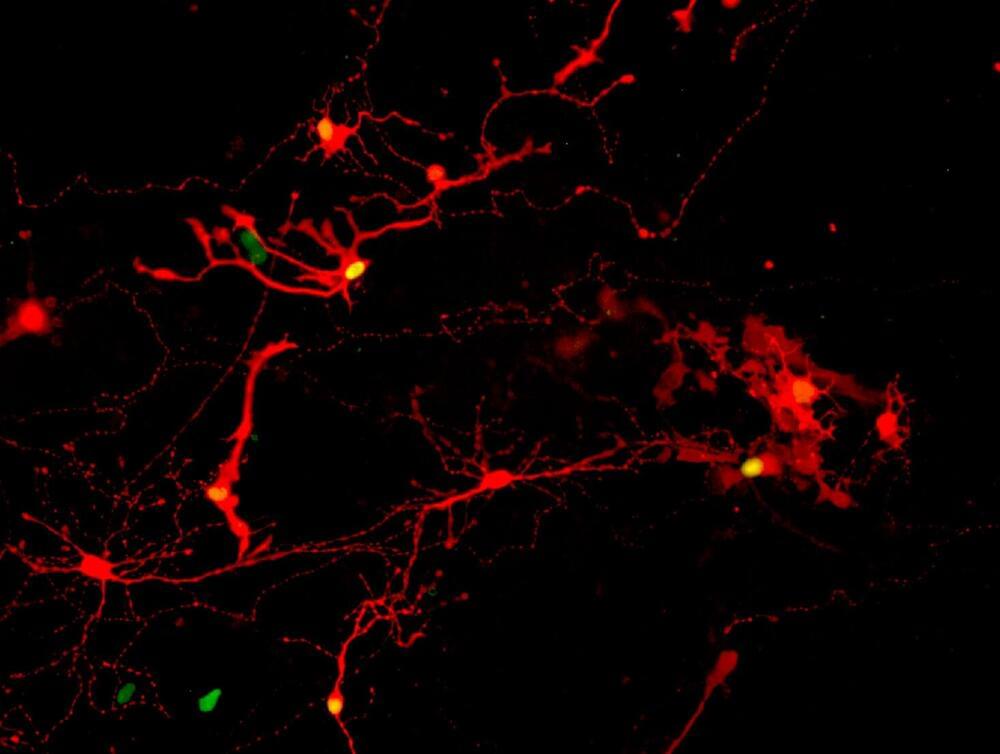As we prepare to leave 2022 behind, let’s take a look at a few of the most noteworthy scientific breakthroughs that happened this year.



𝐋𝐚𝐛-𝐠𝐫𝐨𝐰𝐧 𝐫𝐞𝐭𝐢𝐧𝐚𝐥 𝐞𝐲𝐞 𝐜𝐞𝐥𝐥𝐬 𝐦𝐚𝐤𝐞 𝐬𝐮𝐜𝐜𝐞𝐬𝐬𝐟𝐮𝐥 𝐜𝐨𝐧𝐧𝐞𝐜𝐭𝐢𝐨𝐧𝐬, 𝐨𝐩𝐞𝐧 𝐝𝐨𝐨𝐫 𝐟𝐨𝐫 𝐜𝐥𝐢𝐧𝐢𝐜𝐚𝐥 𝐭𝐫𝐢𝐚𝐥𝐬 𝐭𝐨 𝐭𝐫𝐞𝐚𝐭 𝐛𝐥𝐢𝐧𝐝𝐧𝐞𝐬𝐬
𝙍𝙚𝙩𝙞𝙣𝙖𝙡 𝙘𝙚𝙡𝙡𝙨 𝙜𝙧𝙤𝙬𝙣 𝙛𝙧𝙤𝙢 𝙨𝙩𝙚𝙢 𝙘𝙚𝙡𝙡𝙨 𝙘𝙖𝙣 𝙧𝙚𝙖𝙘𝙝 𝙤𝙪𝙩 𝙖𝙣𝙙 𝙘𝙤𝙣𝙣𝙚𝙘𝙩 𝙬𝙞𝙩𝙝 𝙣𝙚𝙞𝙜𝙝𝙗𝙤𝙧𝙨, 𝙖𝙘𝙘𝙤𝙧𝙙𝙞𝙣𝙜 𝙩𝙤 𝙖 𝙣𝙚𝙬 𝙨𝙩𝙪𝙙𝙮, 𝙘𝙤𝙢𝙥𝙡𝙚𝙩𝙞𝙣𝙜 𝙖 “𝙝𝙖𝙣𝙙𝙨𝙝𝙖𝙠𝙚” 𝙩𝙝𝙖𝙩 𝙢𝙖𝙮 𝙨𝙝𝙤𝙬 𝙩𝙝𝙚 𝙘𝙚𝙡𝙡𝙨 𝙖𝙧𝙚 𝙧𝙚𝙖𝙙𝙮 𝙛𝙤𝙧 𝙩𝙧𝙞𝙖𝙡𝙨 𝙞𝙣 𝙝𝙪𝙢𝙖𝙣𝙨 𝙬𝙞𝙩𝙝 𝙙𝙚𝙜𝙚𝙣𝙚𝙧𝙖𝙩𝙞𝙫𝙚 𝙚𝙮𝙚 𝙙𝙞𝙨𝙤𝙧𝙙𝙚𝙧𝙨.𝙍𝙚𝙩𝙞𝙣𝙖𝙡 𝙘𝙚𝙡𝙡𝙨 𝙜𝙧𝙤𝙬𝙣 𝙛𝙧𝙤𝙢 𝙨𝙩𝙚𝙢 𝙘𝙚𝙡𝙡𝙨 𝙘𝙖𝙣 𝙧𝙚𝙖𝙘𝙝 𝙤𝙪𝙩 𝙖𝙣𝙙 𝙘𝙤𝙣𝙣𝙚𝙘𝙩 𝙬𝙞𝙩𝙝 𝙣𝙚𝙞𝙜𝙝𝙗𝙤𝙧𝙨, 𝙖𝙘𝙘𝙤𝙧𝙙𝙞𝙣𝙜 𝙩𝙤 𝙖 𝙣𝙚𝙬 𝙨𝙩𝙪𝙙𝙮, 𝙘𝙤𝙢𝙥𝙡𝙚𝙩𝙞𝙣𝙜 𝙖 “𝙝𝙖𝙣𝙙𝙨𝙝𝙖𝙠𝙚” 𝙩𝙝𝙖𝙩 𝙢𝙖𝙮 𝙨𝙝𝙤𝙬 𝙩𝙝𝙚 𝙘𝙚𝙡𝙡𝙨 𝙖𝙧𝙚 𝙧𝙚𝙖𝙙𝙮 𝙛𝙤𝙧 𝙩𝙧𝙞𝙖𝙡𝙨 𝙞𝙣 𝙝𝙪𝙢𝙖𝙣𝙨 𝙬𝙞𝙩𝙝 𝙙𝙚𝙜𝙚𝙣𝙚𝙧𝙖𝙩𝙞𝙫𝙚 𝙚𝙮𝙚 𝙙𝙞𝙨𝙤𝙧𝙙𝙚𝙧𝙨.
Retinal cells grown from stem cells can reach out and connect with neighbors, according to a new study, completing a “handshake” that may show the cells are ready for trials in humans with degenerative eye disorders.
Over a decade ago, researchers from the University of Wisconsin-Madison developed a way to grow organized clusters of cells, called organoids, that resemble the retina, the light-sensitive tissue at the back of the eye. They coaxed human skin cells reprogrammed to act as stem cells to develop into layers of several types of retinal cells that sense light and ultimately transmit what we see to the brain.
“We wanted to use the cells from those organoids as replacement parts for the same types of cells that have been lost in the course of retinal diseases,” says David Gamm, the UW-Madison ophthalmology professor and director of the McPherson Eye Research Institute whose lab developed the organoids. “But after being grown in a laboratory dish for months as compact clusters, the question remained—will the cells behave appropriately after we tease them apart? Because that is key to introducing them into a patient’s eye.”

ChatGPT integration with Bing’s search engine.
Microsoft’s Bing search engine might soon become more attuned to users’ needs and return results in a more human-like fashion. According to The Information, the tech giant is planning to incorporate the OpenAI software powering ChatGPT into Bing in hopes that it can help the company catch up to (or maybe even outshine) Google. Microsoft invested $1 billion in OpenAI back in 2019, and more recent reports said it’s in talks with the Elon Musk-founded startup for a follow-up investment. Now, The Information is reporting that Microsoft’s initial investment included an agreement to incorporate some aspects of GPT into Bing.
OpenAI developed GPT as a language model that uses deep learning to generate human-like text responses. Late last year, it launched a program called ChatGPT that quickly skyrocketed in popularity due to its ability to return responses that seem like they were written by actual people. Educators raised concerns that it could easily be used for cheating, since those who tried the tool said they would’ve given its responses a good grade if a student claimed to have written them. ChatGPT is free for now, but OpenAI intends to charge for its use in the future.
What GPT integration would mean for Bing isn’t clear at this point. It doesn’t have the capability to scrape the internet for results, so Microsoft will still use its own search engine technology. However, The Information said it could help Bing present results to users in a friendlier way. A source “familiar with Bing’s systems” told the publication that Microsoft could use the technology to present search results as full sentence answers with the source for the information. If Bing suggests related queries to the original one, GPT could explain their relevance in a meaningful manner. The technology could help Bing suggest better keywords or key phrases to users, as well.
After over a decade of research and testing, Caltech’s Space Solar Power Demonstrator arrived above Earth on Tuesday to begin testing.
The NEO Surveyor will be able to detect individual asteroid heat signatures.
NEO Surveyor is, as the name implies, a satellite specifically designed to survey objects near the Earth (NEO). One of its primary contributions will be to look for asteroids and other small bodies that are potentially on an eventual collision course with Earth but are invisible to typical NEO survey missions because of their location in the solar system.
Typically, their signals are just background noise against the overwhelming signal from the Sun. But NEO Surveyor will be able to detect individual asteroid heat signatures, allowing it to isolate potentially dangerous asteroids using this novel technique. With the increased focus on “planetary defense,” as it has come to be called, NASA has been interested in the mission, which was initially proposed in 2005, for some time.
But, as with all bureaucracies, NASA has budgetary difficulties, and NEO Surveyor was no exception. The agency initially canceled NEO Surveyor’s budget for the fiscal years 2022 and 2023, forcing project scientists and engineers to move on to other projects for their salaries. So when NASA again picked up the bill for the project, it ballooned to $1.2 billion, partly due to the increased inflation throughout the economy in the intervening years.
We are living a data revolution in the biomedical field, and scientific research is advancing at an unprecedented speed to improve modern medicine. One of the key aspects of such medicine is the tailoring of treatments to each patient, by analising the specific changes that led to disease along with the unique characteristics with which the person was born. The use of supercomputers is essential to make sense of the vast amounts of data, and to simulate aspects of our bodies to calculate for instance which drug is more appropriate for each patient for a given disease.
This video showcases some of the research done at the Life Sciences Department of the Barcelona Supercomputing Center, contributing to a better understanding of our bodies in health and disease, and to a future where a Human Digital Twin can help to live healthier and longer.
Greg Yang is a mathematician and AI researcher at Microsoft Research who for the past several years has done incredibly original theoretical work in the understanding of large artificial neural networks. Greg received his bachelors in mathematics from Harvard University in 2018 and while there won the Hoopes prize for best undergraduate thesis. He also received an Honorable Mention for the Morgan Prize for Outstanding Research in Mathematics by an Undergraduate Student in 2018 and was an invited speaker at the International Congress of Chinese Mathematicians in 2019.
In this episode, we get a sample of Greg’s work, which goes under the name “Tensor Programs” and currently spans five highly technical papers. The route chosen to compress Tensor Programs into the scope of a conversational video is to place its main concepts under the umbrella of one larger, central, and time-tested idea: that of taking a large N limit. This occurs most famously in the Law of Large Numbers and the Central Limit Theorem, which then play a fundamental role in the branch of mathematics known as Random Matrix Theory (RMT). We review this foundational material and then show how Tensor Programs (TP) generalizes this classical work, offering new proofs of RMT. We conclude with the applications of Tensor Programs to a (rare!) rigorous theory of neural networks.
Patreon: https://www.patreon.com/timothynguyen.
Part I. Introduction.
00:00:00 : Biography.
00:02:36 : Harvard hiatus 1: Becoming a DJ
00:07:40 : I really want to make AGI happen (back in 2012)
00:09:00 : Harvard math applicants and culture.
00:17:33 : Harvard hiatus 2: Math autodidact.
00:21:51 : Friendship with Shing-Tung Yau.
00:24:06 : Landing a job at Microsoft Research: Two Fields Medalists are all you need.
00:26:13 : Technical intro: The Big Picture.
00:28:12 : Whiteboard outline.
Part II. Classical Probability Theory.
00:37:03 : Law of Large Numbers.
00:45:23 : Tensor Programs Preview.
00:47:25 : Central Limit Theorem.
00:56:55 : Proof of CLT: Moment method.
01:02:00 : Moment method explicit computations.
Part III. Random Matrix Theory.

Although dark matter is a central part of the standard cosmological model, it’s not without its issues. There continue to be nagging mysteries about the stuff, not the least of which is the fact that scientists have found no direct particle evidence of it. Despite numerous searches, we have yet to detect dark matter particles. So some astronomers favor an alternative, such as Modified Newtonian Dynamics (MoND) or modified gravity model. And a new study of galactic rotation seems to support them.
The idea of MoND was inspired by galactic rotation. Most of the visible matter in a galaxy is clustered in the middle, so you’d expect that stars closer to the center would have faster orbital speeds than stars farther away, similar to the planets of our solar system. We observe that stars in a galaxy all rotate at about the same speed. The rotation curve is essentially flat rather than dropping off. The dark matter solution is that galaxies are surrounded by a halo of invisible matter, but in 1983 Mordehai Milgrom argued that our gravitational model must be wrong.
Australian scientists have created the most detailed map ever of the communication links between the hippocampus, the brain’s memory control center, and the rest of the brain, potentially revolutionizing our understanding of human memory.
“We were surprised to find fewer connections between the hippocampus and frontal cortical areas, and more connections with early visual processing areas than we expected to see,” said Dr. Marshall Dalton, a Research Fellow in the School of Psychology at the University of Sydney. “Although, this makes sense considering the hippocampus plays an important role not only in memory but also imagination and our ability to construct mental images in our mind’s eye.”
Located within the brain, the hippocampus is a complex structure that resembles a seahorse. It is essential for the brain and plays a crucial role in memory formation as well as the transfer of memories from short-term to long-term storage. In addition to these functions, the hippocampus also plays a role in navigation, the ability to imagine future or fictitious experiences, the creation of mental imagery, and even in visual perception and decision-making.
